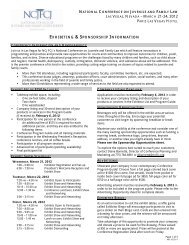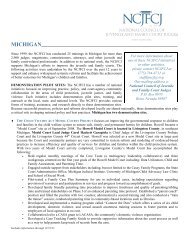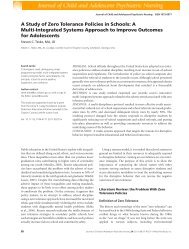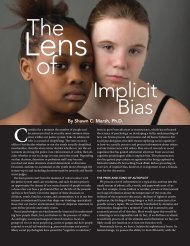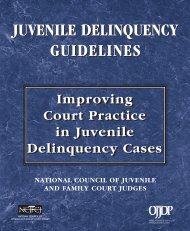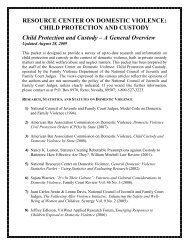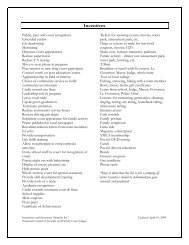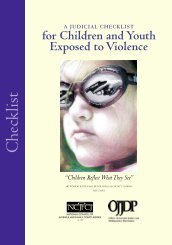The Marijuana Detection Window - National Drug Court Institute
The Marijuana Detection Window - National Drug Court Institute
The Marijuana Detection Window - National Drug Court Institute
- No tags were found...
You also want an ePaper? Increase the reach of your titles
YUMPU automatically turns print PDFs into web optimized ePapers that Google loves.
DRUG COURT PRACTITIONER FACT SHEET<strong>Court</strong>s establishing detection windows forcannabinoids need to be aware of the existenceof research studies indicating prolongedelimination times in urine. It is not recommended,however, that drug courts manipulatetheir detection windows to include theseexceptional findings. Sound judicial practicerequires that court decisions be based uponcase-specific information. In weighing theevidence, courts also acknowledge the realitythat a particular client’s individualities or theuniqueness of circumstances may not alwaysallow the strict application of cannabinoiddetection window parameters in a sentencingdecision. <strong>The</strong>se uncommon events, however,should not preclude the development ofcannabinoid detection windows for the usein the majority of court determinations.CLIENT DETOXIFICATION:THE “CLEAN OUT” PHASEAs a result of the extended elimination ofcannabinoids (as compared to other abuseddrugs), some drug courts have instituted adetoxification stage or “clean out” period inthe first phase of program participation. Thisgrace period allows new clients a definedtime frame for their bodies to eliminate storesof drugs that may have built up over yearsof substance abuse without the fear of courtsanctions associated with a positive drugtest. In many cases this detoxification periodextends for 30 days, which correspondsto the commonly held assumption thatthis represents the time period required formarijuana metabolites to be eliminated froma client’s system.Regardless of the origin of the 30-day marijuanadetection window and its influence on theduration of the detoxification period, 30 daysis certainly an equitable time period for clientdrug elimination purposes. Simply becausethe science may not support the necessity ofa detoxification period of this duration doesnot mean that a court cannot use the 30-dayparameter in order to establish programexpectations. However, based upon the<strong>Court</strong>s are urged to establishdetection benchmarks and utilizethese scientifically supportablecriteria for case disposition.cannabinoid detection guidelines presented inthis review, it is unlikely (utilizing reasonablephysiological or technology criteria) that a drugcourt client would continue to remain cannabinoidpositive at the end of this designatedabstinence period. After 30 days, using eithera 20 or 50 ng/mL testing cutoff, continuedcannabinoid positive urine drug tests almostcertainly indicate marijuana usage at somepoint during the detoxification period andshould provoke a court response to reinforceprogram expectations.ABSTINENCE BASELINE<strong>The</strong> abstinence baseline can either be a pointat which a client has demonstrated theirabstinence from drug use via sequentiallynegative testing results (actual baseline) ora court-established time limit after which aclient should not test positive if that clienthas abstained from marijuana use (scientificbaseline). Each baseline has importance ina court-mandated drug monitoring program.<strong>The</strong> later has been the focus of this review.It is exemplified by establishing the detectionwindow for marijuana and utilizing positiveurine drug testing results to guide courtintervention. Individuals who continue toproduce cannabinoid positive results beyondthe established detection window maximums(the scientific baseline) are subject to sanctionfor failing to remain abstinence during programparticipation.<strong>The</strong> alternative approach uses negative testresults in establishing the actual abstinencebaseline. This has been referred to as the“two negative test approach” and has been11




